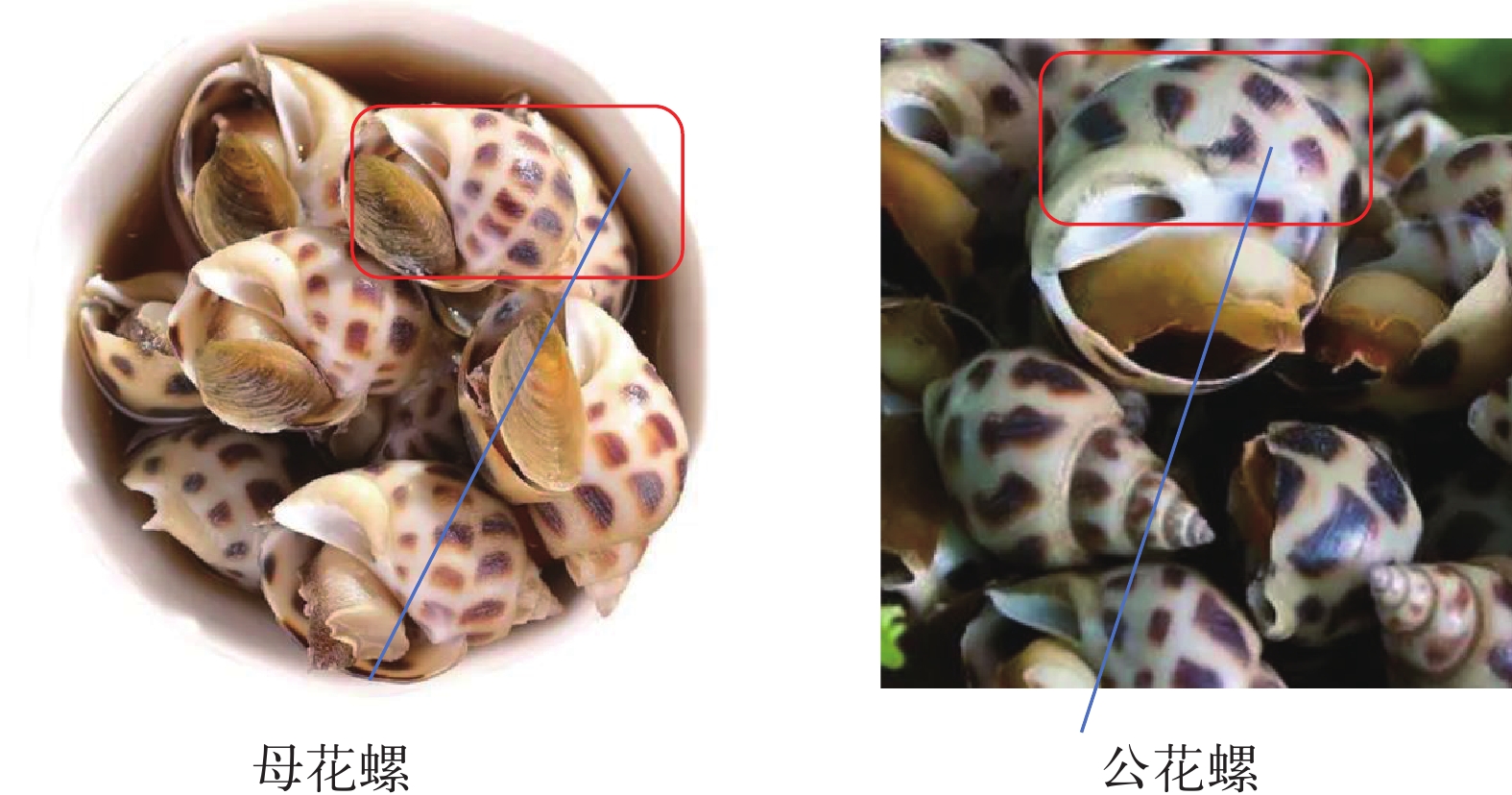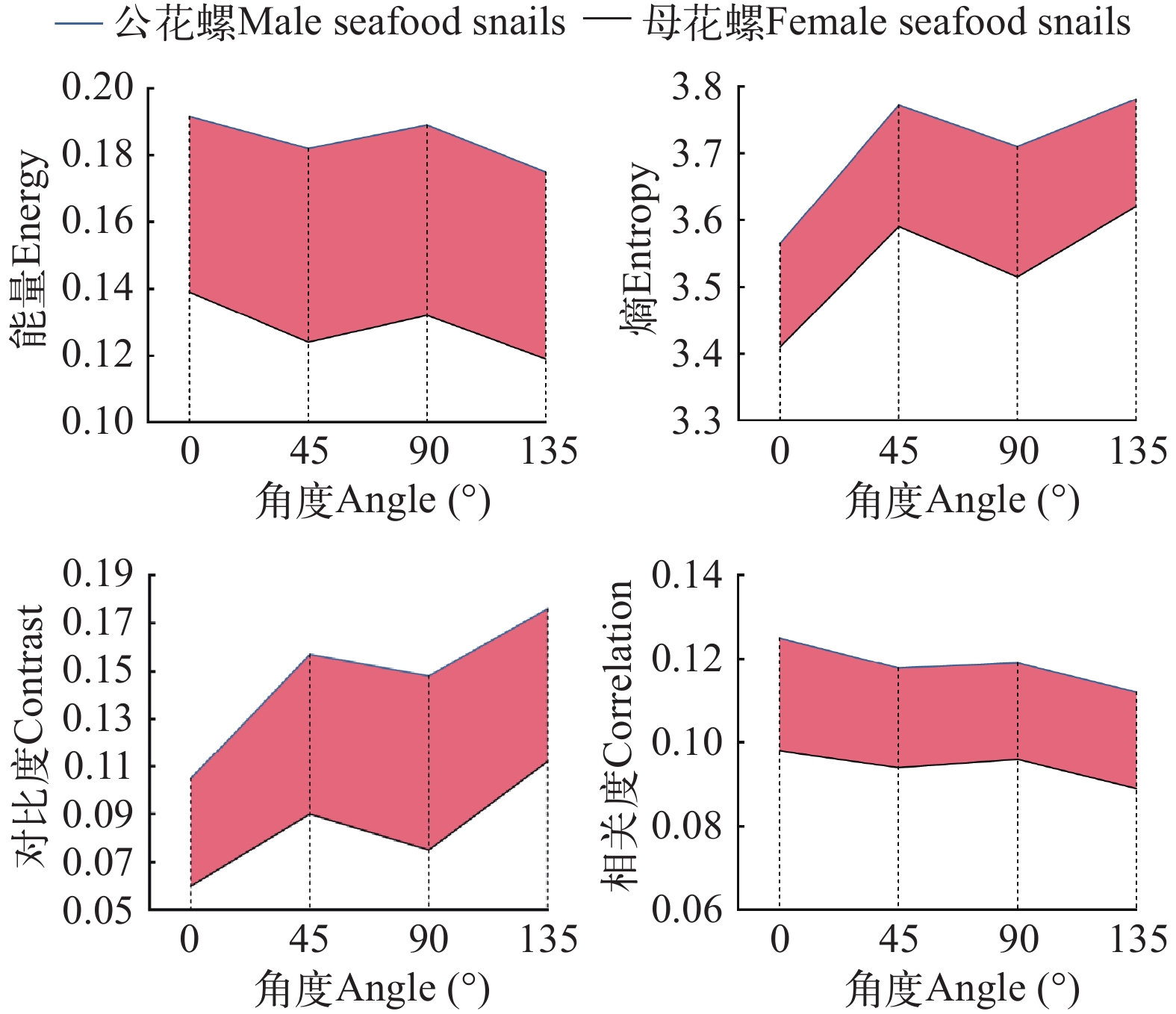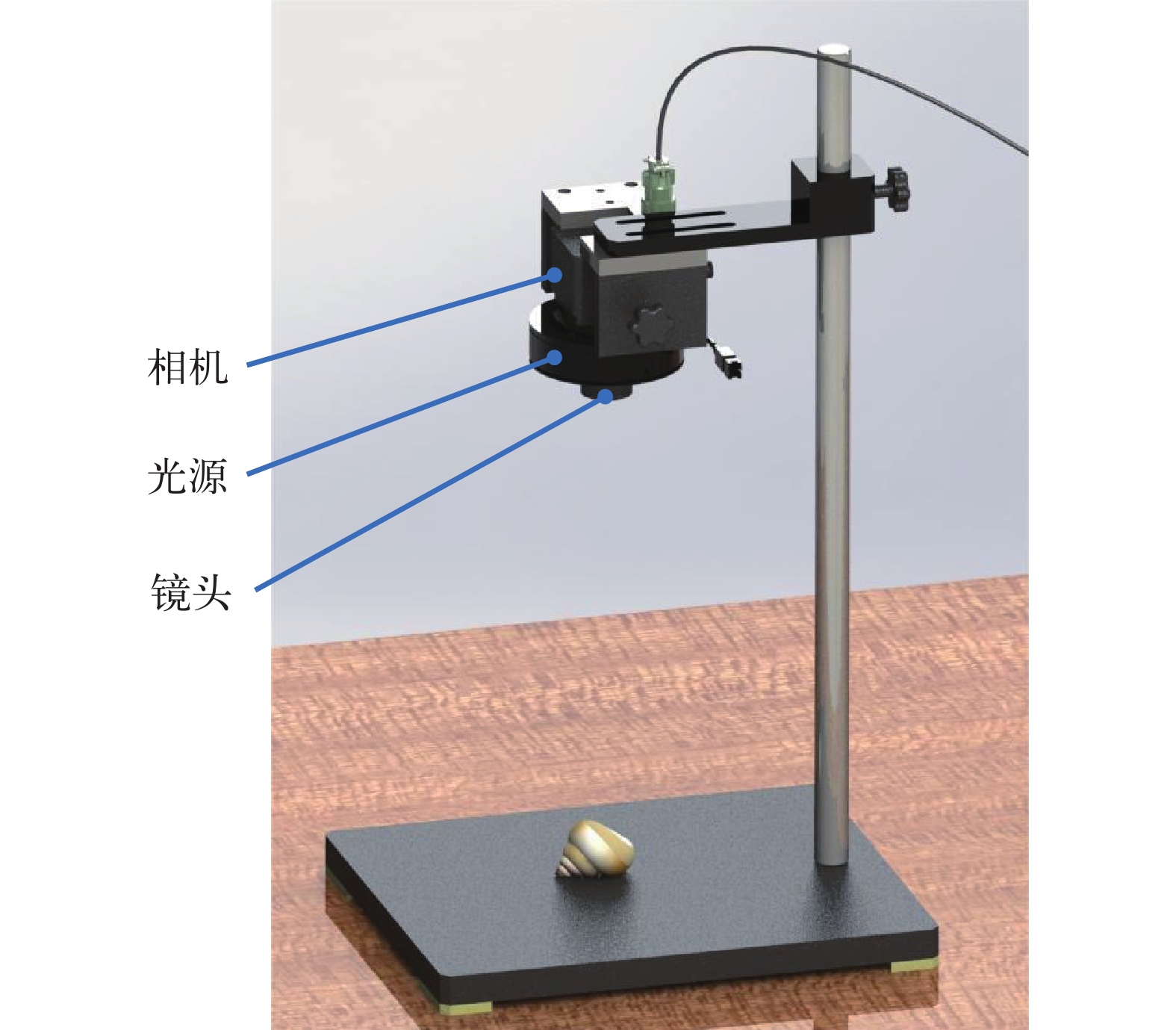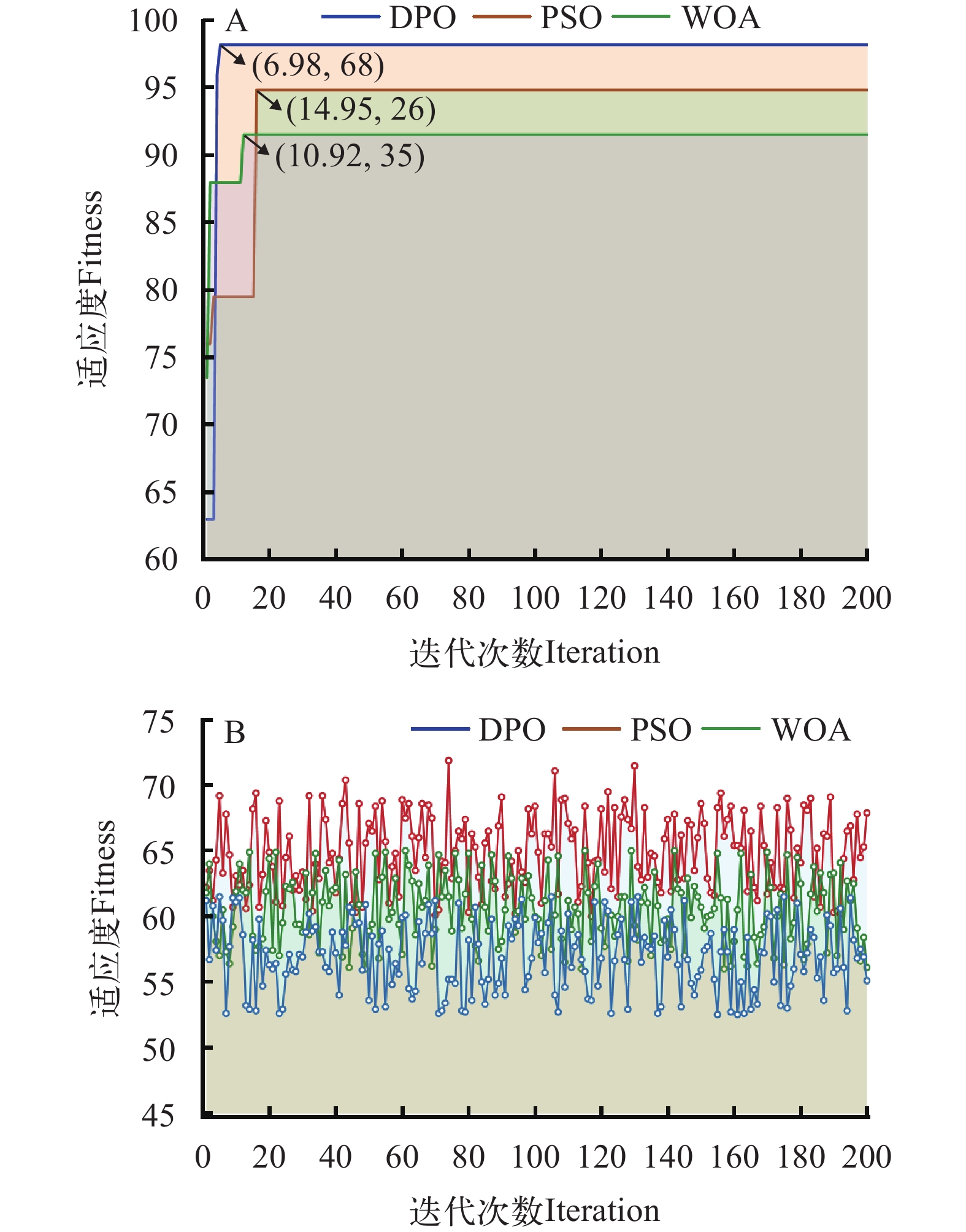RESEARCH AND EXPERIMENTAL STUDY ON THE CLASSIFICATION OF SEAFOOD SNAILS BASED ON MACHINE VISION
-
摘要:
针对目前人工分选海鲜花螺劳动强度大、人工成本高的问题, 研究提出一种DPO-SVM海鲜花螺公母分类模型。通过灰度共生矩阵分析提取海鲜花螺外壳间隔纹理特征量, 采用SVM作为公母分类模型基体, 对不同纹理特征量组合进行分类效果对比, 得出使用能量、熵、对比度3种特征量分类效果最好的结论。针对SVM优化问题, 以PSO和WOA算法为基础提出DPO算法对SVM的重要参数c、g进行优化; 对DPO-SVM性能进行测试, 将测试结果与SVM、PSO-SVM、WOA-SVM测试结果对比。相比于其他3种SVM模型, DPO-SVM分类准确率大幅度提升, 相比于SVM, 分类总准确率由85%上升至100%, 上升了15%; DPO算法提高了单种群优化算法的寻优性能, 相比于PSO算法, DPO算法将最佳适应度从95.26提升至98.68, 提升幅度为3.47%。此外, 达到最佳适应度的迭代次数由14次减少至6次, 下降57.14%, 显著优化了收敛速度。研究结果可为自动分拣装置中海鲜花螺公母分类提供技术参考。
Abstract:Aiming at the current problems of high labour intensity and costs associated with the manual sorting of sea freshwater snails, we proposes a male and female classification model using DPO-SVM. The texture features of the shell intervals were extracted by grey scale covariance matrix analysis, and SVM was used as the classifier to compare the effectiveness of different combinations of texture features. It was concluded that the classification effect of using the energy, entropy, and contrast was the best. To optimize the SVM parameters c and g, the DPO algorithm, based on PSO and WOA algorithms, was introduced. The performance of DPO-SVM was tested and compared with the standard SVM, PSO-SVM, and WOA-SVM models. The results demonstrate that DPO-SVM significantly improves, with overall accuracy rising from 85% to 100%, representing a 15% over the basic SVM model. Additionally, DPO algorithm improves the optimisation seeking performance of the single-species population optimisation algorithm, increasing the best fitness from 95.26 to 98.68 (a 3.47% improvement) and reducing the number of iterations needed to achieve optimal fitness from 14 to 6, a 57.14% decrease ration. The research provides a valuable technical reference for the male and female classification of seafood conchs in automatic sorting device.
-
Keywords:
- Machine vision /
- Flower snail sorting /
- Shell /
- Texture features /
- Support vector machine /
- Algorithm
-
花螺是我国一种著名水产品, 口感鲜美, 具有很高营养价值[1], 公和母花螺在口感上有差异[2], 公和母花螺的销售价格相差较大。目前公母花螺分级主要采用人工挑选分级, 分级依据主要依靠花螺外壳特征。
近年来, 图像处理技术与机器学习技术飞速发展, 在各种水产品分类中已经得到广泛应用。图像处理技术主要用于大小、形状、色泽等特征的提取[3—5], 机器学习技术主要用于将提取出的特征按照某一规则进行分类[6]。当前, 深度学习算法(如YOLO、R-CNN、SSD等)在处理大型数据集和复杂背景下的物体检测和识别方面表现优异。杨眉等[7]提出了一种基于神经网络的扇贝识别方法, 从扇贝轮廓边界中提取分类特征, 通过训练BP神经网络, 实现对扇贝图像识别和分类, 对测试图识别准确率达100%。万鹏等[8]将鱼体外观形态特征、颜色特征、比例特征作为分类依据, 对4种大宗淡水鱼进行品种在线识别, 平均准确率达到92.5%。
应用图像纹理特征分类可以有效地区分不同纹理特征信息的目标, 灰度共生矩阵(Gray Level Co-occurrence Matrix, GLCM)是一种常用的纹理分析方法, 能够综合体现图像灰度在不同方向、相邻距离和变化程度上的信息[9], 欧利国等[10]以灰度共生矩阵来提取3种金枪鱼的纹理特征, 结果表明, 角二阶距、对比度、熵、逆差距、方差和相关性这6项纹理指标能够有效地反映金枪鱼的纹理特征信息。谢忠红等[11]选取鱼背和鱼腹的皮肤图像, 计算鱼类图像的GLCM, 提取熵、相关性和对比度等关键特征, 将其应用于鱼类识别, 在辅助光源和晴天自然光条件下, 对4种鱼的识别正确率均超过98%。Khotimah 等[12]对鱼类整体图像进行了灰度共生矩阵分析, 提取了6项纹理特征, 应用于决策树模型的识别研究, 最终识别准确率达到88%。灰度共生矩阵在相关纹理特征研究中均展现了良好的应用效果。
目前主流的深度学习算法(如YOLO、R-CNN、SSD等)在处理大型数据集和复杂背景下的物体检测和识别方面表现优异。然而, 本研究的数据集相对较小, 且花螺图像背景单一、特征明显。因此, 深度学习方法的优势难以完全体现。此外, 深度学习算法通常需要较大的计算资源和更长的训练时间。相比之下, 支持向量机(Support Vector Machines, SVM)在处理小样本数据和高维数据时表现出色, 且训练速度较快, 模型简单易于理解[13]。SVM的核函数参数c和惩罚因子g是影响其性能的关键因素, 在SVM参数优化中, 种群算法因其实现简便、效率高等特点被广泛应用[13]。但单一的种群算法仍存在一些缺陷, 粒子群优化算法(Partical Swarm Optimization, PSO)易陷入局部最优, 鲸优化算法(Whale Optimization Algorithm, WOA)存在收敛速度慢, 求解精度较低的问题[14, 15], 因此, 种群算法仍有很大的改进空间。提升算法的全局搜索能力以提高其准确率, 是当前应用种群算法的主要难点。有学者对融合不同种群算法优势改进单一种群算法进行研究。乔寅威等[16]针对WOA存在收敛速度慢和易陷入局部最优的问题, 提出一种基于融合差分进化算法与柯西扰动的改进鲸算法, 并使用了Tent混沌映射和精英反向学习的种群初始化(DE-WOA), 用于优化Elman神经网络进行空气质量指数模型预测。Gaganpreet Kaur 等[17]提出利用混沌搜索策略改进WOA算法, 采用混沌映射概率进行计算, 充分利用混沌的普遍性和非重复性特点, 与WOA中的随机搜索算法相比, 提升了整体搜索速度和收敛效率。Mostafa Bozorgi 等[18]针对WOA因早熟收敛导致计算精度较低的问题, 结合了差分进化算法和鲸鱼优化算法, 更有效地寻找到全局最优解。
综上, 本文采用SVM作为海鲜花螺公母分类模型, 通过灰度共生矩阵提取花螺纹理特征, 通过种群算法对SVM的核函数参数c和惩罚因子g进行寻优。为克服单一种群算法易陷入局部最优及优化精度不足的问题, 结合了PSO和WOA算法, 提出了一种DPO算法。确定DPO-SVM结构。本研究的难点在于筛选出花螺纹理中最具区分性的特征量组合, 并且融合种群算法设计出合适的SVM参数寻优算法, 以期研究结果为将来的海鲜花螺公母自动分拣装置的设计优化提供一定的技术参考。
1. 海鲜花螺的纹理特征提取
1.1 灰度共生矩阵
图像纹理是由图像上具有一定规则分布的灰度组合重复出现而产生的, GLCM是研究图像上相邻像素点阵之间灰度分布关系的矩阵, 它可以反映图像灰度的变化信息, 以及相同灰度级的像素之间的位置分布特征[19]。由图 1可知, 公花螺外壳具有纹路较粗、凹槽较深的特点, 相对而言, 母花螺的外壳纹路较细, 凹槽相对较浅, 这便使得公花螺外壳的灰度级分布相对比较复杂, 因此可以利用GLCM提取公花螺外壳的灰度纹理特征来进行公母分类。
1.2 纹理特征参数提取
GLCM理论常用的4种关键纹理特征量为能量、熵、对比度和相关度[19], 具体描述如下:
(1)能量ASM的表达式
$$ {\mathrm{ASM}} = \sum\limits_i {\sum\limits_j {p\;{{\left( {i,j} \right)}^2}} } $$ (1) 式中, i、j为图像中某一点对的灰度值, p (i, j)为该点对出点的概率。
(2)熵ENT的表达式
$$ {\mathrm{ENT}} = - \sum\limits_{\text{i}} {\sum\limits_{\text{j}} {p\left( {i,j} \right) \cdot } \log p\left( {i,j} \right)} $$ (2) (3)对比度CON的表达式
$$ {\mathrm{CON}} = {\sum\limits_i {\sum\limits_j {(i - j)} } ^2}p\left( {i,j} \right) $$ (3) 式中, (i–j)为该点对的灰度差。
(4)相关度CORR的表达式
$$ {\mathrm{CORR}} = \frac{{\displaystyle\sum\limits_i {\sum\limits_j {\left( {\left( {ij} \right)p\left( {i,j} \right)} \right) - {\mu _x}{\mu _y}} } }}{{{\sigma _x}{\sigma _y}}} $$ (4) 式中, μx、μy为均值, σx、σy为标准差。
在分拣时, 花螺通过输送带进入到分拣机, 由于花螺外壳的形状和重心分布, 其会呈现侧躺的姿态, 即花螺的螺旋壳体的长轴与地面大致平行, 本试验提取花螺四个角度(0°, 45°, 90°, 135°)的图片, 依据上述公式计算出公和母花螺外壳的四个角度的GLCM特征量及均值。图 2为4个纹理特征量的均值, 图 3为不同纹理特征量在四个角度下的参数结果, 红色部分是公母花螺纹理特征量在四个角度下的参数值的差距。分析可知, 公和母花螺外壳的纹理特征的能量、熵、对比度和相关度值均有区别, 因此可以通过灰度纹理特征量区分公花螺和母花螺。
2. DPO-SVM公母分类模型
2.1 支持向量机(SVM)
SVM是一种二分类模型, 其特点是间隔最大化, 能够寻找分开不同类型样本数据且具备最大分类间隔的最优分类超平面[20—22]。因此, 采用SVM构建海鲜花螺公母分类模型。
2.2 DPO算法
SVM模型的泛化能力和学习性能在很大程度上受到核函数参数c和惩罚因子g的影响[23, 24]。PSO与WOA等新型算法有良好的收敛性和优化精度被广泛用于参数寻优[25, 26]。因此, 本研究结合PSO和WOA算法对SVM的参数c和g进行优化。PSO算法源于对鸟群觅食行为的研究[27]。设种群规模(粒子数)为n; 总迭代(进化)次数Tmax; 当前迭代次数为T, 当前粒子的位置为Xt; 当前粒子的速度为Vt。
每个粒子速度更新公式:
$$ {V_{t + 1}} = \omega \cdot {V_t} + {c_1} \cdot {r_1} \cdot ({P_{\mathrm{b}}} - {X_t}) + {c_2} \cdot {r_2} \cdot ({g_{\mathrm{b}}} - {X_t}) $$ (5) 式中, Vt+1为更新后的粒子移动速度; ω为惯性权值; c1和c2分别为个体学习因子和社会学习因子; r1、r2为2个不相同的[0, 1]间随机数; Pb为粒子目前的个体最优解; gb为粒子目前的全局最优解。
粒子位置更新公式:
$$ {X_{t{\text{ + }}1}} = {V_{t + 1}} + {X_t} $$ (6) 式中, Xt+1为更新后的粒子位置。
WOA算法是模仿自然界中鲸捕食行为的新型群体智能优化算法[28], 引入系数变量A=2ar3–a, 式中, r3为[0, 1]的随机数, a随着迭代次数的增加, 从2至0线性递减, 当A的取值不在[–1, 1]时, 鲸个体会选择搜索捕食的位置更新方式, 当前鲸个体可能不会向当前最佳鲸个体靠近, 而是从鲸群体中随机选择一条鲸个体靠近, 这虽然会使得当前鲸个体偏离目标猎物, 但会增强算法的全局搜索能力。
鲸搜索捕食的数学模型:
$$ \left\{ \begin{gathered} {X^{j + 1}} = {X^{{\mathrm{rand}}}} - A \cdot D' \\ D' = \left| {C \cdot {X^{{\mathrm{rand}}}} - {X^j}} \right| \\ C = 2 \cdot {r_4} \\ \end{gathered} \right. $$ (7) 式中, Xrand为当前鲸群体中一个随机个体位置, X j为当前鲸个体所在位置, X j+1为当前鲸个体的下一个位置, r4为[0, 1]间的随机数。
PSO算法具备高精度优化和快速收敛的优势, 但也容易陷入局部最优[29], 而WOA算法中的搜索捕食过程增强了全局搜索的能力, 但牺牲了寻优精度与速度, 因此可将2个算法的优势融合, 综合2种算法优势提出一种直接偏好优化算法(Direct Preference Optimization, DPO)。首先, 引入变量权重到PSO速度更新公式, 以提升全局优化精度; 其次, 将WOA中捕食后鲸位置纳入PSO的位置更新, 使群体在全局随机更新时也能进行局部优化, 从而兼顾效率与精度; 最后, 通过动态调整变量权重, 快速锁定初期最优解并提升后期个体多样性, 扩展搜索空间。
DPO算法个体速度更新公式:
$$ \left\{ \begin{gathered} {V_{t + 1}} = {\omega _{\text{v}}} \cdot {V_t} + {c_1} \cdot {r_1} \cdot ({P_{\rm{b}}} - {X^{j + 1}}) + {c_2} \cdot {r_2} \cdot ({g_{\rm{b}}} - {X^{j + 1}}) \\ {\omega _{\rm{v}}} = {\omega _{\max }} - \left( {{\omega _{\max }} - {\omega _{\min }}} \right) \cdot \left( {{T \mathord{\left/ {\vphantom {T {{T_{\max }}}}} \right. } {{T_{\max }}}}} \right) \\ \end{gathered} \right. $$ (8) 式中, Vt为DPO算法中个体目前移动速度, Vt+1为DPO算法中更新后的个体移动速度, ωv为速度变量惯性权值, ωmax为最大惯性权值, ωmin为最小惯性权值, T/Tmax为个体目前迭代次数与总迭代次数的比值。
DPO算法个体位置公式:
$$ \left\{ \begin{gathered} {V_{t + 1}} = {\omega _{\text{v}}} \cdot {V_t} + {c_1} \cdot {r_1} \cdot ({P_{\mathrm{b}}} - {X^{j + 1}}) + {c_2} \cdot {r_2} \cdot ({g_{\mathrm{b}}} - {X^{j + 1}}) \\ {\omega _{\mathrm{v}}} = {\omega _{\max }} - \left( {{\omega _{\max }} - {\omega _{\min }}} \right) \cdot \left( {{T \mathord{\left/ {\vphantom {T {{T_{\max }}}}} \right. } {{T_{\max }}}}} \right) \\ \end{gathered} \right. $$ (9) 式中, Xt+1为DPO算法中更新后的个体位置, ωx为位置变量惯性权值。
2.3 DPO-SVM模型
DPO-SVM算法流程: 首先, 构建SVM模型并归一化输入数据, 初始化核函数参数c和惩罚因子g。然后, 使用DPO算法优化c和g, 并初始化个体速度和位置。接着, 计算适应度以确定个体和群体极值。每个个体先根据WOA算法更新位置, 再采用DPO算法调整位置和速度, 同时计算适应度并更新极值。最后, 检查终止条件, 若满足, 则将最优个体值赋给SVM的c和g, 并训练模型。
3. DPO-SVM分类模型性能试验
3.1 试验材料与设备
为验证DPO-SVM分类模型性能, 使用成熟上市的海鲜花螺作为试验材料, 公、母各300只, 一共600只样本; 使用由相机、镜头、光源及支架组成的试验图像采集装置进行图像采集(图 4); 在VScode中使用Python+Open CV提取花螺外壳纹理信息, 以MATLAB R2018b作为DPO -SVM模型的执行软件。
3.2 试验方案
首先, 采用图像采集装置对花螺外壳图像进行采集, 在VScode软件中使用Python+Open CV对图像进行灰度化处理后编写计算GLCM的能量、熵、对比度和相关度的程序实现纹理特征参数获取, 获得公母纹理特征参数共600组, 将其储存在Excel表。
其次, 将Excel表格中的数据导入MATLAB R2018b软件, 对4种纹理特征选取3种进行组合, 制作成不同种类的数据集, 使用SVM对每个数据集进行分类测试, 选择分类效果最好的3种纹理特征参数作为分类数据。
最后, 根据分类效果最好的3种灰度纹理特征参数制作数据集, 在600组数据中, 随机选取公母各100组, 共200组作为DPO-SVM模型的测试样本, 其余400组作为训练样本, 进行DPO-SVM分类模型训练与测试。
3.3 结果
纹理特征参数选择 SVM对不同纹理特征量组合的分类效果以精准度、准确率、召回率和F1值为评价指标(表 1)。
表 1 不同特征量的分类效果Table 1. Classification effects of different feature quantities特征量组合
Eigenvalue combination训练集Train set 测试集Test set 平均准确率 (%) 平均精度 (%) 平均召回率 (%) 平均 F1值 (%) 平均准确率 (%) 平均精度 (%) 平均召回率 (%) 平均 F1值 (%) 能量、熵、对比度
Energy, Entropy, and Contrast87 85 88 84 85 86 87 85 能量、熵、相关度
Energy, Entropy, and Correlation78 76 74 74 75 75 77 76 熵、对比度、相关度
Entropy, Contrast, and Correlation77 79 76 80 74 76 75 77 由不同纹理特征组合后使用SVM算法进行分类后的准确率可以得出, 使用能量、熵、对比度3种纹理特征对花螺公母的分类效果最好, 总准确率为85%; 对于花螺公母的分类成功率分别为95%与75%。因此, 选择能量、熵、对比度三个灰度特征参数来制作DPO-SVM分类模型性能测试的数据集。
分类模型性能测试结果 为验证DPO-SVM模型的性能, 同时执行SVM、PSO-SVM模型、WOA-SVM模型和DPO-SVM模型, 选取公母分类的准确率、分类的总准确率作为评价模型的性能指标(表 2)。
表 2 不同算法的分类准确率Table 2. Classification accuracy of different algorithms模型
Modelling类型
Type准确率
Accuracy
(%)总准确率
Overall
accuracy (%)平均检测时间
Average detection
time (s)SVM 公 95 85 0.070 母 75 WOA- SVM 公 100 92.5 0.069 母 85 PSO- SVM 公 100 95 0.078 母 90 DPO- SVM 公 100 100 0.072 母 100 由表 2可知, SVM模型的整体准确率为85%, 公母花螺的识别率分别为95%和75%; WOA-SVM和PSO-SVM模型对公花螺的识别率均为100%, 证明了种群算法在SVM参数优化中的有效性。但对母花螺的识别率为85%和90%, 说明单一种群优化算法仍存在局限; DPO-SVM模型能够正确识别公母, 发挥了WOA算法与PSO算法的优势, 总准确率达到了100%, 相较于SVM模型, 总准确率提升了15%, 且平均测试时间达到了0.072s, 满足了花螺实时分拣的需求。适应度定义为当前迭代次数对应核函数参数c和惩罚因子g的DPO- SVM训练模型分类准确度适应度计算见式10。
$$ f({x_i}) = \sum\limits_{k = 1}^s {[{t_k} - {p_k}(} {x_i})] $$ (10) 式中, $ f({x_i}) $、$ {t_k} $、$ {p_k} $、$ s $分别为适应度函数, 实际观测值、预测值、训练样本总数。$ {x_i} $,为惩罚因子g和核函数参数c。
最佳适应度是每次进化后种群中适应度最高的个体, 平均适应度则是所有个体适应度之和除以个体总数的结果。图 5a和5b展示了3种优化算法的最佳适应度曲线与平均适应度曲线, 表 3为不同算法最优c、g解。
表 3 不同优化算法的最优解Table 3. Optimal solutions of different algorithms fitness优化算法
Optimization algorithm最优解Optimal solution 核函数参数
Kernel function
parameter (c)惩罚因子
Penalty factor
(g)WOA 39.2354 0.0184 PSO 58.9721 0.0432 DPO 62.8287 2.4843 图 5可知, 相较PSO算法, DPO算法最佳适应度由95.26上升至98.68, 提高3.47%, 达到最佳适应度时的迭代次数由14下降至6, 下降57.14%, 通过在位置更新公式中引入变量权重, DPO算法显著提升了收敛效果和寻优效率, 且DPO算法在迭代过程中整体平均适应度高于PSO和WOA算法。
根据式10, 通过DPO的寻优目标, 即通过粒子寻优获取一组最佳参数惩罚因子g和核函数参数c的组合, 由表 3可知DPO算法寻得的最优解c、g分别为62.8287和2.4843, 结合图 5可知, DPO算法的最佳适应度和平均适应度, 均高于其他模型, 表明寻得的c、g解最靠近最优解。PSO算法寻得的最优解c、g分别为58.9721和0.0432, 与DPO算法的最优解有明显差距, 图 5B显示出PSO算法最佳适应度为95.26, 低于DPO算法度, 说明了PSO算法寻得的解为局部最优解。
综上, DPO-SVM算法能够准确地对花螺公母进行分类, 能满足自动化分级机器的应用需求。
4. 讨论
本文提出一种DPO-SVM海鲜花螺公母分类模型, 通过灰度共生矩阵分析提取海鲜花螺外壳间隔纹理特征量; 采用SVM作为公母分类模型基体, 对不同纹理特征量组合进行分类效果对比。结果表明, 使用能量、熵、对比度3种特征量分类效果最好; 针对SVM优化问题, 以PSO和WOA算法为基础提出DPO算法对SVM的重要参数c、g进行优化, 对比使用SVM、PSO-SVM和WOA-SVM的识别效果, 得出DPO-SVM性能最优的结论。
为了提取出图像中的有效特征值, 唐振三等[30]采用 GLCM 提取的纹理特征参数, 对比两类薯皮图像特征参数间的差异, 选择差异较小的薯皮图像特征组合进行统计分析和分类识别, 通过构建SVM分类模型可实现基于机器视觉的马铃薯薯皮粗糙度分级; 商德勇等[31]利用灰度共生矩阵提取煤矸图像的4个纹理特征信息(对比度、能量、同质性和相关性), 融合灰度和纹理特征组成特征向量组, 采用支持向量机(SVM)进行煤矸数据集训练与分类检测识别。 最终, 利用试验平台进行机器人标定和煤矸图像识别分拣实验。因此, 本文同样采用了特征量组合, 为寻找合适的特征量, 对不同纹理特征量组合, 采用SVM进行分类效果对比, 获得了最优参数组合为能量、熵及对比度, 准确率可达85%。
为进一步优化SVM参数, 高海燕等[32]通过PSO算法寻优SVM参数,获得优化的SVM分类模型, 准确率为99.50%, 平均识别时间为0.048s, 满足机器人的分拣需要, 为本文优化SVM模型提供了思路。本文以PSO和WOA算法为基础提出的DPO算法, 花螺识别准确度达到100%, 且优于SVM、PSO-SVM、WOA-SVM的识别效果, 平均检测时间为0.072s, 满足了花螺实时分拣的需求。
综上, 应用DPO-SVM模型可以有效分类公母海鲜花螺, 具有一定的工程应用价值。但实际应用中花螺图像的质量可能因拍摄环境和设备等因素而有所不同; 需要根据拍摄图像尺寸、对感光度(ISO)、镜头光圈等参数选择合适; 同时, 图像噪声会对机器识别产生干扰, 还需进一步探明中值滤波、维纳滤波等图像处理方法。
5. 结论
针对海鲜花螺公母分类中的纹理特征提取和SVM参数优化问题, 本文提出了DPO-SVM模型。通过GLCM提取纹理特征, 并结合DPO算法优化SVM的参数c、g, 提升了分类准确率和寻优性能。主要结论:
(1)本研究提出了一种DPO-SVM海鲜花螺公母分类模型, 通过GLCM分析提取海鲜花螺外壳间隔纹理特征量, 采用SVM作为公母分类模型的基体, 对不同纹理特征量组合进行分类效果对比, 得出使用能量、熵、对比度3种特征量分类效果最好的结论。
(2)针对SVM优化问题, 以PSO和WOA算法为基础进一步提出了DPO算法对SVM的重要参数c、g进行优化; 对DPO-SVM的性能进行测试, 并将测试结果与SVM、PSO-SVM、WOA-SVM的测试结果进行对比。相比于其他3种SVM模型, DPO-SVM分类准确率大幅度提升, 相比于SVM, 分类总准确率由85%上升至100%, 上升了15%; DPO算法提高了单种群优化算法的寻优性能, 相比于PSO算法, DPO算法将最佳适应度从95.26提升至98.68, 提升幅度为3.47%。此外, 达到最佳适应度的迭代次数由14次减少至6次, 下降57.14%。本文研究可为自动化分拣装置中海鲜花螺公母分类提供参考。
-
表 1 不同特征量的分类效果
Table 1 Classification effects of different feature quantities
特征量组合
Eigenvalue combination训练集Train set 测试集Test set 平均准确率 (%) 平均精度 (%) 平均召回率 (%) 平均 F1值 (%) 平均准确率 (%) 平均精度 (%) 平均召回率 (%) 平均 F1值 (%) 能量、熵、对比度
Energy, Entropy, and Contrast87 85 88 84 85 86 87 85 能量、熵、相关度
Energy, Entropy, and Correlation78 76 74 74 75 75 77 76 熵、对比度、相关度
Entropy, Contrast, and Correlation77 79 76 80 74 76 75 77 表 2 不同算法的分类准确率
Table 2 Classification accuracy of different algorithms
模型
Modelling类型
Type准确率
Accuracy
(%)总准确率
Overall
accuracy (%)平均检测时间
Average detection
time (s)SVM 公 95 85 0.070 母 75 WOA- SVM 公 100 92.5 0.069 母 85 PSO- SVM 公 100 95 0.078 母 90 DPO- SVM 公 100 100 0.072 母 100 表 3 不同优化算法的最优解
Table 3 Optimal solutions of different algorithms fitness
优化算法
Optimization algorithm最优解Optimal solution 核函数参数
Kernel function
parameter (c)惩罚因子
Penalty factor
(g)WOA 39.2354 0.0184 PSO 58.9721 0.0432 DPO 62.8287 2.4843 -
[1] 杨富. 进口海鲜抢“鲜”入境 电商货物结群闯世界 [N]. 成都日报, 2023-12-12 (2).] Yang F. Imported seafood rush “fresh” into the country e-commerce goods in groups to break into the world [N]. Chengdu Daily, 2023-12-12 (2). [
[2] 文怡. 美味花螺煮一下再炒 [J]. 家庭医药. 快乐养生, 2017(10): 14.] Wen Y. Delicious snails cooked before frying [J]. Home Medicine, 2017(10): 14. [
[3] 黄浩诚, 朱桂莹, 许菁茹, 等. 基于图像的井下人员安全防护检测系统设计 [J]. 现代信息科技, 2023, 7(24): 121-125.] Huang H C, Zhu G Y, Xu J R, et al. Design of safety protection detection system for underground personnel based on images [J]. Modern Information Technology, 2023, 7(24): 121-125. [
[4] 汪正兴, 夏世法, 杨伟才. 基于数字图像处理的沥青封闭层老化状态识别方法研究 [J]. 水利技术监督, 2023, 31(12): 20-23.] doi: 10.3969/j.issn.1008-1305.2023.12.007 Wang Z X, Xia S F, Yang W C. Research on aging evaluation method of asphalt sealing layer based on digital image processing [J]. Technical Supervision in Water Resources, 2023, 31(12): 20-23. [ doi: 10.3969/j.issn.1008-1305.2023.12.007
[5] 孙星宇, 王平, 吕志华, 等. 基于条形码识别的农产品消毒分类装置 [J]. 南方农机, 2023, 54(18): 34-36+72.] doi: 10.3969/j.issn.1672-3872.2023.18.008 Sun X Y, Wang P, Lü Z H, et al. Sterilisation sorting device for agricultural products based on barcode identification [J]. China Southern Agricultural Machinery, 2023, 54(18): 34-36+72. [ doi: 10.3969/j.issn.1672-3872.2023.18.008
[6] 王倩. 基于深度学习技术的教育大数据挖掘领域运用探究 [J]. 数字通信世界, 2023(11): 112-114.] doi: 10.3969/J.ISSN.1672-7274.2023.11.036 Wang Q. Research on the application of education big data mining based on deep learning technology [J]. Digital Communication World, 2023(11): 112-114. [ doi: 10.3969/J.ISSN.1672-7274.2023.11.036
[7] 杨眉, 魏鸿磊, 华顺刚. 一种基于神经网络的扇贝图像识别方法 [J]. 大连海洋大学学报, 2014, 29(1): 70-74.] doi: 10.3969/J.ISSN.2095-1388.2014.01.015 Yang M, Wei H L, Hua S G. A scallop image recognition method based on a neural network [J]. Journal of Dalian Ocean University, 2014, 29(1): 70-74. [ doi: 10.3969/J.ISSN.2095-1388.2014.01.015
[8] 万鹏, 潘海兵, 龙长江, 等. 基于机器视觉技术淡水鱼品种在线识别装置设计 [J]. 食品与机械, 2012, 28(6): 164-167.] doi: 10.3969/j.issn.1003-5788.2012.06.040 Wan P, Pan H B, Long C J, et al. Design of the on-line identification device of freshwater fish species based on machine vision technology [J]. Food & Machinery, 2012, 28(6): 164-167. [ doi: 10.3969/j.issn.1003-5788.2012.06.040
[9] 雷雨果, 梁楠, 刘春梅. 图像纹理特征分析及提取方法 [J]. 软件工程, 2022, 25(7): 5-8.] Lei Y G, Liang N, Liu C M. Image texture feature analysis and extraction method [J]. Software Engineering, 2022, 25(7): 5-8. [
[10] 欧利国, 李汶龙, 刘必林, 等. 基于计算机视觉的3种金枪鱼属鱼类表型纹理特征分析 [J]. 中国水产科学, 2022, 29(5): 770-780.] doi: 10.12264/JFSC2021-0506 Ou L G, Li W L, Liu B L, et al. Analysis of phenotype texture features of three Thunnus species based on computer vision [J]. Journal of Fishery Sciences of China, 2022, 29(5): 770-780. [ doi: 10.12264/JFSC2021-0506
[11] 谢忠红, 郭小清, 程碧云, 等. 基于多特征的淡水鱼种类识别研究 [J]. 扬州大学学报(农业与生命科学版), 2016, 37(3): 71-77.] Xie Z H, Guo X Q, Cheng B Y, et al. Species recognition of fishes based on multiple features [J]. Journal of Yangzhou University (Agricultural and Life Science Edition), 2016, 37(3): 71-77. [
[12] Khotimah W N, Arifin A Z, Yuniarti A, et al. Tuna Fish Classification using Decision Tree Algorithm and Image Processing Method [C]. 2015 International Conference on Computer, Control, Informatics and Its Applications (IC3INA). October 5-7, 2015. Bandung, Indonesia. IEEE, 2015: 126-131.
[13] Fu L, Ouyang H, Zhang C, et al. A constrained cooperative adaptive multi-population differential evolutionary algorithm for economic load dispatch problems [J]. Applied Soft Computing, 2022(121): 108719.
[14] 张建伟, 江琦, 刘轩然, 等. 基于PSO-SVM算法的梯级泵站管道振动响应预测 [J]. 农业工程学报, 2017, 33(11): 75-81.] doi: 10.11975/j.issn.1002-6819.2017.11.010 Zhang J W, Jiang Q, Liu X R, et al. Prediction of vibration response for pipeline of cascade pumping station based on PSO-SVM algorithm [J]. Transactions of the Chinese Society of Agricultural Engineering, 2017, 33(11): 75-81. [ doi: 10.11975/j.issn.1002-6819.2017.11.010
[15] Xu L, Cao M, Song B. A new approach to smooth path planning of mobile robot based on quartic Bezier transition curve and improved PSO algorithm [J]. Neurocomputing, 2022, 473(2): 98-106.
[16] 乔寅威, 贾新春, 关燕鹏, 等. 基于DE-WOA的Elman神经网络的空气质量预测方法及应用 [J/OL]. 控制工程, 1-8 [2023-12-25] Qiao Y W, Jia X C, Guan Y P, et al. Air quality prediction method and application of Elman neural network based on DE-WOA [J/OL]. Control Engineering, 1-8 [2023-12-25] [
[17] Kaur G, Arora S. Chaotic whale optimization algorithm [J]. Journal of Computational Design and Engineering, 2018, 5(3): 275-284. doi: 10.1016/j.jcde.2017.12.006
[18] Mostafa Bozorgi S, Yazdani S. IWOA: an improved whale optimization algorithm for optimization problems [J]. Journal of Computational Design and Engineering, 2019, 6(3): 243-259. doi: 10.1016/j.jcde.2019.02.002
[19] 刘光宇, 黄懿, 曹禹, 等. 基于灰度共生矩阵的图像纹理特征提取研究 [J]. 科技风, 2021(12): 61-64.] Liu G Y, Huang Y, Cao Y, et al. Research on extraction of image texture feature based on gray co-occurrence matrix [J]. Technology Wind, 2021(12): 61-64. [
[20] Yang G G, Bao Y D, Liu Z Y. Localization and recognition of pests in tea plantation based on image saliency analysis and convo- lutional neural network [J]. Transactions of the Chinese Society of Agricultural Engineering, 2017, 33(6): 156-162.
[21] 李昕, 陈泽君, 李立君, 等. 基于偏好免疫网络和SVM算法的油茶果多特征识别 [J]. 农业工程学报, 2020, 36(22): 205-213.] doi: 10.11975/j.issn.1002-6819.2020.22.023 Li X, Chen Z J, Li L J, et al. Recognition of Camellia multi-features based on preference artificial immune network and support vector machine [J]. Transactions of the Chinese Society of Agricultural Engineering, 2020, 36(22): 205-213. [ doi: 10.11975/j.issn.1002-6819.2020.22.023
[22] 单亚峰, 段金凤, 付华, 等. 基于SSA-AdaBoost-SVM的变压器故障诊断 [J]. 控制工程, 2022, 29(2): 280-286.] Shan Y F, Duan J F, Fu H, et al. Transformer fault diagnosis based on SSA-AdaBoost-SVM [J]. Control Engineering of China, 2022, 29(2): 280-286. [
[23] 周建民, 王发令, 张臣臣, 等. 基于特征优选和GA-SVM的滚动轴承智能评估方法 [J]. 振动与冲击, 2021, 40(4): 227-234.] Zhou J M, Wang F L, Zhang C C, et al. An intelligent method for rolling bearing evaluation using feature optimization and GA-SVM [J]. Journal of Vibration and Shock, 2021, 40(4): 227-234. [
[24] 杨柳, 孙金华, 冯仲科, 等. 基于PSO-LSSVM的森林地上生物量估测模型 [J]. 农业机械学报, 2016, 47(8): 273-279.] doi: 10.6041/j.issn.1000-1298.2016.08.036 Yang L, Sun J H, Feng Z K, et al. Estimation model of forest above-ground biomass based on PSO-LSSVM [J]. Transactions of the Chinese Society for Agricultural Machinery, 2016, 47(8): 273-279. [ doi: 10.6041/j.issn.1000-1298.2016.08.036
[25] Liu W, Guo G, Chen F, et al. Meteorological pattern analysis assisted daily PM2.5 grades prediction using SVM optimized by PSO algorithm [J]. Atmospheric Pollution Research, 2019, 10(5): 1482-1491. doi: 10.1016/j.apr.2019.04.005
[26] 李素, 袁志高, 王聪, 等. 群智能算法优化支持向量机参数综述 [J]. 智能系统学报, 2018, 13(1): 70-84.] doi: 10.11992/tis.201707011 Li S, Yuan Z G, Wang C, et al. Optimization of support vector machine parameters based on group intelligence algorithm [J]. CAAI Transactions on Intelligent Systems, 2018, 13(1): 70-84. [ doi: 10.11992/tis.201707011
[27] 吴志勇, 戴弌, 鞠传香, 等. 基于鲸鱼优化算法的多目标多式联运路径选择 [J]. 重庆交通大学学报(自然科学版), 2022, 41(5): 6-13.] Wu Z Y, Dai Y, Ju C X, et al. Multi-objective multimodal transportation route selection based on whale optimization algorithm [J]. Journal of Chongqing Jiaotong University (Natural Science), 2022, 41(5): 6-13. [
[28] Tatsumi K, Ibuki T, Tanino T. A chaotic particle swarm optimization exploiting a virtual quartic objective function based on the personal and global best solutions [J]. Applied Mathematics and Computation, 2013, 219(17): 8991-9011. doi: 10.1016/j.amc.2013.03.029
[29] 曹旺. MATLAB智能优化算法: 从写代码到算法思想 [M]. 北京: 北京大学出版社, 2021.] Cao W. MATLAB Intelligent Optimization Algorithm: From Writing Code to Algorithm Thought [M]. Beijing: Peking University Press, 2021. [
[30] 唐振三, 袁剑龙, 康亮河, 等. 基于图像特征识别的马铃薯薯皮粗糙度分级研究 [J]. 中国农业科学, 2023, 56(22): 4428-4440.] doi: 10.3864/j.issn.0578-1752.2023.22.006 Tang Z S, Yuan J L, Kang L H, et al. Potato Tuber skin roughness classification analysis based on image characteristics recognition [J]. Scientia Agricultura Sinica, 2023, 56(22): 4428-4440. [ doi: 10.3864/j.issn.0578-1752.2023.22.006
[31] 商德勇, 黄云山, 张天佑, 等. Delta煤矸分拣机器人实验平台设计 [J]. 煤炭技术, 2023, 42(7): 136-139.] Shang D Y, Huang Y S, Zhang T Y, et al. Design of experimental platform for coal gangue sorting Delta robot [J]. Coal Technology, 2023, 42(7): 136-139. [
[32] 高海燕, 高晋阳, 王伟成. 基于改进PSO-SVM的生产线分拣机器人罐装食品识别方法 [J]. 食品与机械, 2023, 39(9): 89-94.] Gao H Y, Gao J Y, Wang W C. Identification method of canned food for production line sorting robot based on improved PSO-SVM [J]. Food & Machinery, 2023, 39(9): 89-94. [




 下载:
下载:



